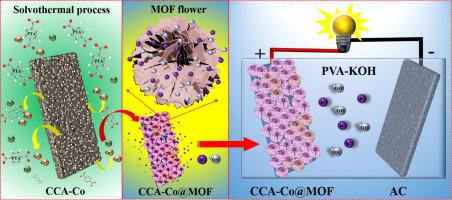Journal of Colloid and Interface Science ( IF 9.4 ) Pub Date : 2022-11-12 , DOI: 10.1016/j.jcis.2022.11.038
Kai Zhao 1 , Xiaolin Sun 1 , Hucheng Fu 1 , Hanwen Guo 1 , Lei Wang 1 , Da Li 2 , Jingquan Liu 1

|
The intelligent use of regenerable and degradable biomass materials to substitute the synthetic materials can bring huge economic benefits and environmental improvements. In addition, metal-organic framework (MOF) based cathode materials are becoming a research hotspot for supercapacitors. Here, Co nanoparticle-modified nitrogen self-doped porous carbonized chitosan aerogel (CCA-Co) precursors were prepared by sol-gel, freeze-drying technique and carbonization process using biomass chitosan particles and cobalt compounds as raw materials. Then the layered composite (CCA-Co@MOF) was obtained by growing Co-doped Ni MOF (Co-Ni MOF) with CCA-Co precursor as the carrier. Notably, the presence of Co nanoparticles in carbonized chitosan aerogel (CCA) not only promotes the self-assembly of CCA and MOF, but also etched Co ions can participate in the growth of MOF, resulting in excellent electrochemical performance. Specifically, the specific capacitance of CCA-Co@MOF reaches 1877.2 F g-1, which is much superior to CCA-M@MOFs (M = Ni, Zn and Cu) and other contrast materials. Furthermore, the asymmetric supercapacitor (CCA-Co@MOF//AC ASC) assembled using CCA-Co@MOF and activated carbon (AC) electrodes, exhibits a high energy density (45.9 Wh kg-1 at 431.7 W kg-1). This work highlights the advantages of metal nanoparticle-modified and carbonized chitosan aerogels for MOF growth, demonstrating its great value in the field of electrochemical energy storage.
中文翻译:

在壳聚糖衍生的氮自掺杂多孔碳上原位构建用于高性能超级电容器的金属有机骨架
智能使用可再生、可降解的生物质材料替代合成材料,可以带来巨大的经济效益和环境改善。此外,基于金属有机骨架(MOF)的正极材料正成为超级电容器的研究热点。在此,以生物质壳聚糖颗粒和钴化合物为原料,通过溶胶-凝胶、冷冻干燥技术和碳化工艺制备了 Co 纳米颗粒修饰的氮自掺杂多孔碳化壳聚糖气凝胶 (CCA-Co) 前体。然后通过以CCA-Co前驱体为载体生长Co掺杂Ni MOF(Co-Ni MOF)获得层状复合材料(CCA-Co@MOF)。值得注意的是,碳化壳聚糖气凝胶 (CCA) 中 Co 纳米颗粒的存在不仅促进了 CCA 和 MOF 的自组装,而且蚀刻的 Co 离子可以参与 MOF 的生长,从而产生优异的电化学性能。具体来说,CCA-Co@MOF的比电容达到1877.2 F g-1,远优于 CCA-M@MOFs(M = Ni、Zn 和 Cu)等对比材料。此外,使用 CCA-Co@MOF 和活性炭 (AC) 电极组装的非对称超级电容器 (CCA-Co@MOF//AC ASC) 表现出高能量密度(在 431.7 W kg -1 时为 45.9 Wh kg -1 )。这项工作突出了金属纳米粒子修饰和碳化的壳聚糖气凝胶对 MOF 生长的优势,展示了其在电化学储能领域的巨大价值。































 京公网安备 11010802027423号
京公网安备 11010802027423号